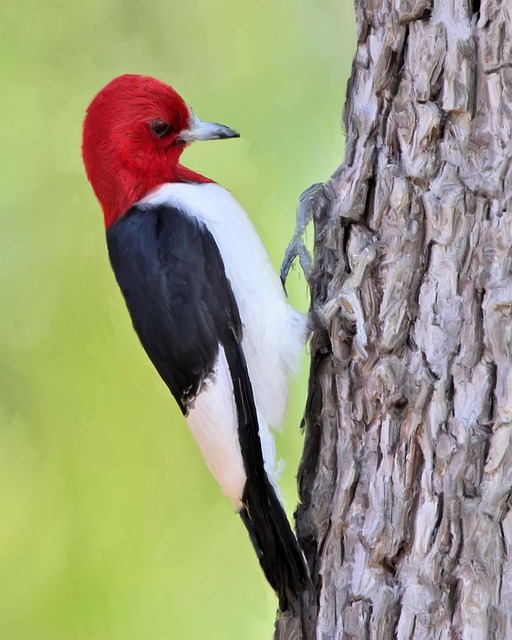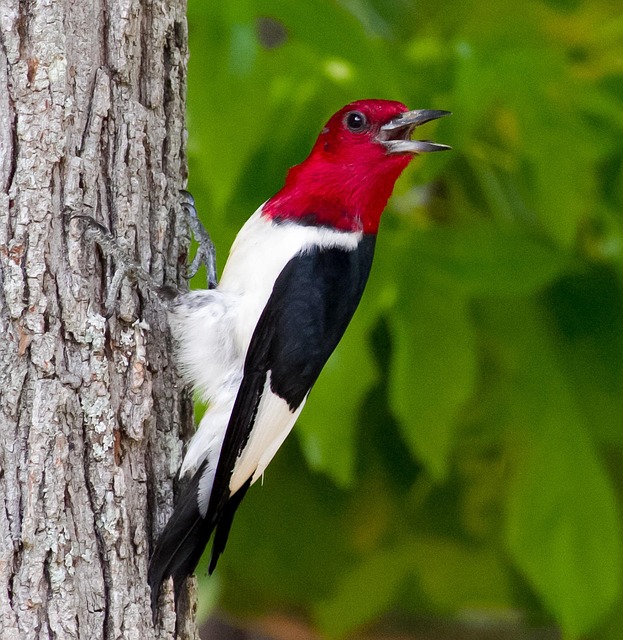There are birds, and then there are sights. The Red-headed Woodpecker is firmly in the latter.
In a world of subtle browns and gentle streaks, this bird is a flying piece of graphic art. It’s not just a bird with a red head; it’s a bird with a personality as bold and striking as its plumage. With its solid crimson “helmet,” jet-black back, and snow-white belly, it looks like a living, breathing Art Deco poster.
But here’s a common problem: many people think they’ve seen a Red-headed Woodpecker, but they’re often mistaken. This bird is not the common visitor you see at your suet feeder. It’s a special, and unfortunately, increasingly rare sighting.
Here’s why this bird is America’s most striking, and what makes it truly unique.

Wait… Are You Sure It’s a Red-headed Woodpecker?
This is the most important first step. The Red-headed Woodpecker is one of the most misidentified birds in North America, all thanks to its much more common cousin.
Let’s clear this up right now.
-
The REAL Red-headed Woodpecker: Has a solid, bright crimson-red “helmet” that covers its entire head, throat, and neck. Its back is solid jet-black, and it has huge, bold white patches on its wings.
-
The (Common) Red-bellied Woodpecker: This is the bird you likely see in your backyard. It has a “zebra-striped” back, and the male has a simple red “mohawk” that runs from his bill to the back of his neck. (And its “red belly” is just a faint, peachy wash).
If the bird has a striped back, it’s a Red-bellied. If its entire head looks like it was dipped in a can of red paint, you’ve found the real deal.
A “Flying Work of Art”
The “striking” label isn’t just about the head. It’s the whole package. This is one of the only woodpeckers that is a bold, tri-colored pattern. The contrast between the jet-black back, snow-white belly, and crimson head is unmatched.
In flight, this pattern is just as dramatic. The bird shows off massive white patches on the inner half of its wings, which flash like a semaphore against its black wingtips. Unlike many birds, the male and female look identical, sharing the same stunning plumage.
It’s a Woodpecker That Acts Like a Flycatcher
While Red-headed Woodpeckers will drill for insects and excavate nests in dead trees (called “snags”), their behavior is wildly different from other woodpeckers.
They are expert “flycatchers.”
A Red-headed Woodpecker will find a high, exposed perch—like the branch of a dead tree—and sit, watching. When an insect flies by, it will sally out, snatch the bug clean out of the air, and return to its perch to eat it. This aerial hunting is a rare, specialized skill that sets it apart.

They Are Master Food Hoarders (Cachers)
This bird is the ultimate prepper. The Red-headed Woodpecker is one of the few woodpeckers that will actively hoard and store food, a behavior called “caching.”
They will spend hours in the fall collecting acorns, beechnuts, and corn. But they don’t just pile them in one spot. They meticulously wedge each nut or kernel into a crevice, a fence post, a roof shingle, or under a piece of bark. They are known to store food in this way over a vast territory, and they will fiercely defend their stash from Blue Jays, squirrels, and even other woodpeckers.
Quick Facts: The Red-headed Woodpecker
Scientific Name: Melanerpes erythrocephalus
Habitat: Open, deciduous forests, park-like settings, river bottoms, and areas with many dead trees (snags) for nesting.
Diet: True omnivores. They eat insects (especially those caught in mid-air), acorns, nuts, seeds, and fruit.
Conservation Status: Vulnerable / Near Threatened. Populations have declined severely over the last 50 years.
A Beautiful Bird in Decline
The Red-headed Woodpecker’s boldness is, unfortunately, matched by its vulnerability. Populations have dropped by over 60% since the 1970s. This is due to two main factors:
-
Habitat Loss: We’ve become too “tidy.” The bird relies entirely on dead trees (snags) for nesting, roosting, and caching. The removal of these trees from forests and urban areas leaves them with nowhere to live.
-
Competition: The aggressive, invasive European Starling is a major problem. Starlings will fight the woodpeckers for their freshly-dug nest cavities and often win, pushing them out of prime nesting spots.
Conclusion: A True Treasure
The Red-headed Woodpecker is not just another bird. It’s an experience. To see one—with its bold, graphic-novel coloring and its acrobatic, fly-catching antics—is to see a true icon of the American forest.
It’s a “striking” bird in every sense of the word: beautiful, bold, and in a fight for its future.
Have you been lucky enough to see a true Red-headed Woodpecker? Share your story in the comments below!



